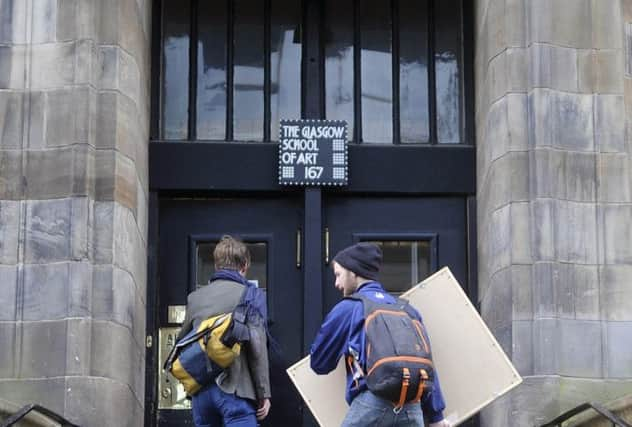Glasgow School of Art: A shrine and a foundry


Under acrid grey palls of smoke, generations of artists and creatives gathered this afternoon to witness first hand a devastating fire tear through the Mackintosh building of the Glasgow School of Art (GSA).
From the foothills of Sauchiehall Street at its crossing with Pitt Street, a viewpoint that ordinarily draws awestruck reverence from those who gaze up towards the crest of Garnethill, there was only tears and heartbreak at the sight of the architectural masterpiece of Charles Rennie Mackintosh immersed in flames.
Advertisement
Hide AdFrom teenage students who had only recently taken their first steps in the Mac to established artists with treasured memories of working in the natural light of its vast spaces, they described their devastation at the apparent destruction of the building’s most iconic features, including its library and the hen run, a famous corridor offering unrivalled views of the city below.
Some onlookers, like artist Jane Sutherland, have had a lifelong relationship with the internationally acclaimed structure, first studying sculpture in its basement in 1979 before completing her masters in the hen run four years later. She later worked as the GSA before recently embarking on a continued education course into the creation of stained glass.
“I’ve been weeping for hours,” she told The Scotsman. “What’s gone - the library and the archive - is irreplaceable. I think of Garnethill as the gem in the heart of the city, and the Glasgow School of Art is the brightest diamond of them all.”
“Everyone who has been to the art school carries it in their hearts for the rest of their life. This is a loss that will be felt around the world.”
A grand vision that was realised between 1897 and 1908, the Mac may have been shaped by the city, but in return, it has shaped Glasgow, informing and inspiring its cultural aesthetic for generations.
Its alumni have formed the bedrock of Scotland’s creative industries in particular a golden thread of four Turner Prize winning artists, including Martin Boyce and Douglas Gordon. This year, three of the four candidates for the prestigious award studied at the school.
Advertisement
Hide AdYet its influence went far beyond those whose with an zeal for the visual arts alone. From actors and playwrights to writers, musicians and politicians, some of the best known figures in the nation’s public life soaked up the Mac’s rarified air, among them Robbie Coltrane, Tilda Swinton, Peter Capaldi, John Byrne, Liz Lochhead and Alasdair Gray.
Whereas the Mac might easily have fallen silent and turned into a museum, it has never stopped being a nexus for working artists, a haven for the purposeful and the eccentric whether they be enthused by embroidery or engineering.
Advertisement
Hide AdFor the latest inductees to the school, the loss was just as keenly felt. Amy Leighbird and Ross McIntosh, both 18, hugged one another as flames licked the three-storey library window frames on the building’s south face.
Ms Leighbird, a fine art student, said. “The atmosphere of the building and the way it allowed students to interact is something that can’t be replaced. It’s so hard to comprehend what has happened.”
Mr McIntosh, a design undergraduate, added: “When you walked into it, you realised it was different, it was special. It’s the place you become an artist, it’s that simple. I was only in the building yesterday looking at the degree show coming together, it’s devastating.”
Filmmaker Martin Clark, 42, who graduated from the GSA in fine art photography in 2003, was haunched over his bicycle, looking on as the fire strengthened its grip on the building.
The Mac’s greatest virtue, he reasoned, was the way in which it allowed aspiring artists to work and exhibit in such esteemed surroundings.
He said: “It’s an absolute tragedy. The building will be renovated but I doubt students will be allowed to have their degree shows there, which is so sad.
Advertisement
Hide Ad“It’s such an inspiring place to work in and the most upsetting thing is knowing that can’t happen now and of all the beautiful things that have been lost.”
Only in the coming days after the full extent of the damage is surveyed will it be possible to tell whether the Mac will once again fulfil its purpose.
Advertisement
Hide AdThe building, described by Scotland’s inaugural first minister, Donald Dewar, as a “magnificently battered working institution,” can rely on a deep well of support from its alumni and admirers.
To them, restoring it the Mac to its glory will be nothing less than an obligation, a means of repaying the inspiration Mackintosh’s building has given them dow the years.
“I’ve worked in every building in the art school but the Mac is its shining treasure,” reflected Ms Sutherland. “If you lay your hand on the fabric of the place, its visceral. Every time you go through its doors, you think of the hands that have touched the woodwork before you.
“Everyone who has been to the art school carries it in their hearts for the rest of their life. This is a loss that will be felt around the world.”